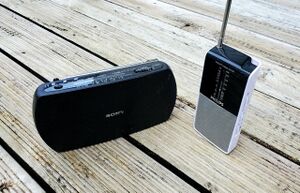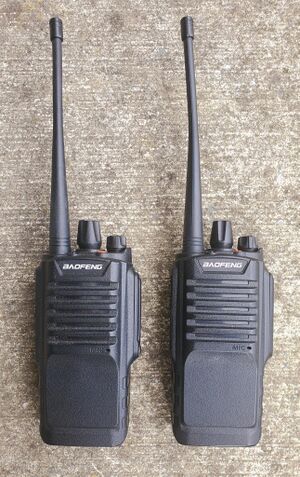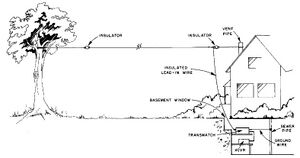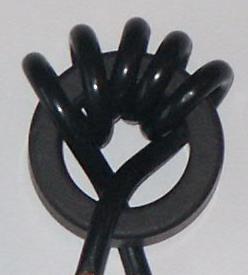Radio
Introduction
This page introduces radio as a practical and reliable communications infrastructure for use in a situations and events where Internet access and mobile communications are not available.
The Internet and mobile networking are complex infrastructures dependent on a stack of technology for their function, from internet exchanges to routing and switching hardware, submarine cables, base stations and their antennae and a stable power grid. This complexity introduces multiple points of vulnerability. For instance, a flood could damage a power station, causing a black out that results in no Internet access at home nor mobile data, texts or calls via the cellular network.
It is here that radio offers a valuable fallback technology for not only receiving critical status updates and information from local authorities and other communities, but also can allow for transmissions from your own community or group that can help you reach others and get needed assistance.
AM(MW)/FM radio reception
In an emergency where critical infrastructure is experiencing outage, local information will almost always be broadcast over AM (also referred to as Medium Wave) and/or FM. It is for this reason, at the least, a simple AM(MW)/FM radio with charged batteries and spares should be acquired and stored in an accessible place. They can usually be bought very cheaply.

It is good to buy am AM(MW)/FM radio with a mini-jack socket and extendable antenna. The mini-jack socket allows for plugging in headphones which can be useful when reception quality is poor. The extendable antenna can greatly aid in finding and receiving a broadcast.
Small radios such as these can be put into a backpack or 'go bag', alongside a spare set of batteries. Rechargeable batteries should be used where possible. It can be a good idea to waterproof your radio by putting it in a quality zip-lock bag, alongside spare batteries held together with a rubber band or tape. Be sure you have tested it and have learned how to use it before you do.
If you are caught out without a radio and have access to a vehicle, it very likely has a built-in AM(MW)/FM radio. Note that AM broadcasts travel over vastly longer distances than FM, and so it is important to be aware of this in relation to your geographical context. As always the best reception with radio is line-of-sight. While it is rare we can see the antenna(e) we are receiving a broadcast from, getting to a position of altitude away from RF (radio-frequency) occlusions like buildings and hills can make all the difference in reception.
Walkie-talkies

Unlike AM(MW)/FM radios detailed above, walkie-talkies are both broadcast station and receiver, and so known as 'two-way' radios. The range of a modern walkie-talkie is anything from a few hundred meters in a city and in dense vegetation, to many kilometers when used on a peak or high rooftop. This communication tool can be especially invaluable when you are in a group and need to split up, staying in contact and relaying information.
Walkie-talkies operate on license-free broadcast frequency ranges in the UHF (Ultra High Frequency) band respective to the region the walkie talkie is purchased within. In the EU the allocation is known PMR446 (Private Mobile Radio, 446 MHz)[1], whereas in the US it is typically the Family Radio Service (FRS)[2] or GMRS[3], and in Australia UHF CB[4].
Regardless, if you are in a region using 2 or more walkie-talkies operating on unlicensed bands, they will still function. Typically walkie-talkies include a channel selector for selecting a pre-agreed channel to operate on. This selector is either a button or dial. It is important to agree on a channel to use before splitting up your group and using the walkie-talkies. Some walkie talkies also include an AM/FM radio scanner, allowing the operator to quickly find and tune into a local radio station. Some even include NOAA weather radio receivers.
When selecting a walkie-talkie it is good to ensure it has a high IPX water rating, is durable, has a 'squelch' function (allows for 'cleaning' up a noisy signal to hear it better), good battery life and has at least 3W of power. Importantly, some walkie-talkies can only be charged in a special charging dock, and so if you choose a walkie-talkie of this sort it is important that it has removable batteries such that you can bring pre-charged batteries with you. If not, it is good to get walkie-talkies that take AA batteries, that you can recharge in a standard battery charger, one of which may include a portable solar charger.
Random Wire Antenna
While far more efficient antenna designs exist, when long range reception is urgently needed, a simple but powerful antenna can be quickly built using shielded or un-shielded copper wire. Such wire can be a single core of common electrical wire used to wire a home, or any copper wire thick enough to withstand the strain of being strung taut between two points. Of all the wires, copper-clad steel wire between 1.6 to 2.0 mm is best however [5].

The length of a random wire antenna should correspond to the bands you wish to listen to, and should be at minimum 1/4 of the wavelength of the band at which you wish to receive. As a quick reference, if you are wanting to listen for local shortwave (AM/MW) broadcasts, a 5.8M length of wire will give you opportunity to listen to many stations within the popular range of 505 kHz at 13.2475 MHz and from stations further away than can typically be reached with a small handheld radio (as shown above). This is probably your best option in an emergency situation with little at hand.
A common configuration for random wire antennae is that of a wire suspended between a home (or shelter) and a tree or adjacent structure. A loop can be made in the wire, twisted tight, and paracord or rope used to fasten it to each end. It is important that the wire is electrically insulated from the structures it is tethered to. Paracord or rope can be covered in an insulating plastic at the points of contact with the wire. If just using wire to affix to the structures, ceramic insulators can be added inline. In the absence of insulators, a ceramic cup with a sturdy handle can be used, with each portion of wire twisted to each end of the handle and the cup horizontal.
Random wire antennas are ever at risk of electrical storms, and so such an antenna should be electrically grounded. For this exposed metal plumping pipe can be used, or a steel stake driven deep into the ground.

At the receiving end of the random wire antenna, a balun is ideally used. A balun 'balances' an unbalanced line, significantly improving reception quality and mitigating for many Standing Wave Ratio (SWR) challenges, typical of long lines of wire used in a radio context[6]. Baluns can be made using a simple toroidal core commonly harvested from electronics at hand, or a professional balun can be purchased suitable for the project.
Random wire antennae for hobby and amateur radio bands
During emergencies hobby and amateur radio (HAM) bands can be a source of valuable information. Radio operators operating in their homes or 'radio shack' may send broadcasts on popular 20M, 40M and 80M bands. These are long-distance bands, sometimes covering hundreds or thousands of kilometers, and so this should be kept in context when seeking information. It is also important to beware the operators of these bands are not necessarily providing authoritative situational status information. For this reason, AM/MW bands should be the preferred choice for reception when mobile data and Internet connectivity is not possible.
If you are wanting to listen to broadcasts from popular amateur radio bands, with far larger wavelengths (like 40M, 80M), you can try any very long wire you can get your hand on. Very long wires can allow for tuning across several bands, as the wire will include 1/4, 1/2 and perhaps even full wavelength representations. However, reception will likely suffer from interference due to a phenomenon known as Standing Wave Ratio (SWR) due to differences in impedance between the antenna itself and the feedline to the receiver [7]. Physicists have studied random wire electromagnetic fields and with the aid of computer modeling have determined ideal lengths for minimal interference. J. C. Sprott, a physicist at University of Wisconsin, USA, has calculated the optimal lengths for reception of the most widely used bands of 1.8-2, 3.5-4, 7-7.3, 10.1-10.15, 14-14.350, 18.068-18.168, 21-21.45, 24.89-24.99, and 28-29.7 MHz[8].
A summary table produced by Sprott follows.
Citations
- ↑ https://en.wikipedia.org/wiki/PMR446
- ↑ https://en.wikipedia.org/wiki/Family_Radio_Service
- ↑ https://www.fcc.gov/wireless/bureau-divisions/mobility-division/general-mobile-radio-service-gmrs
- ↑ https://en.wikipedia.org/wiki/UHF_CB
- ↑ https://en.wikipedia.org/wiki/Random_wire_antenna
- ↑ https://en.wikipedia.org/wiki/Balun
- ↑ https://en.wikipedia.org/wiki/Standing_wave_ratio#Practical_implications_of_SWR
- ↑ https://sprott.physics.wisc.edu/technote/randwire.htm